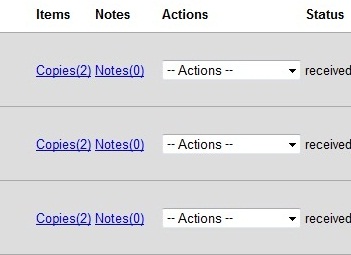Invoices
Introduction
You can create invoices for purchase orders, individual line items, and blanket purchases. You can also link existing invoices to purchase order.
You can invoice items before you receive the items if desired. You can also reopen closed invoices, and you can print all invoices.
Creating invoices and adding line items
You can add specific line items to an invoice from the PO or acquisitions search results screen. You can also search for relevant line items from within the invoice interface. In addition, you can add all line items from an entire Purchase order to an invoice or you can create a blanket invoice for items that are not attached to a purchase order.
Creating a blanket invoice
You can create a blanket invoice for purchases that are not attached to a purchase order.
-
Click Acquisitions → Create invoice.
-
Enter the invoice information in the top half of the screen.
-
To add charges for materials not attached to a purchase order, click Add Charge… This functionality may also be used to add shipping, tax, and other fees.
-
Select a charge type from the drop-down menu.
New charge types can be added via Administration → Acquisitions Administration → Invoice Item Types. -
Select a fund from the drop-down menu.
-
Enter a Title/Description of the resource.
-
Enter the amount that you were billed.
-
Enter the amount that you paid.
-
Save the invoice.
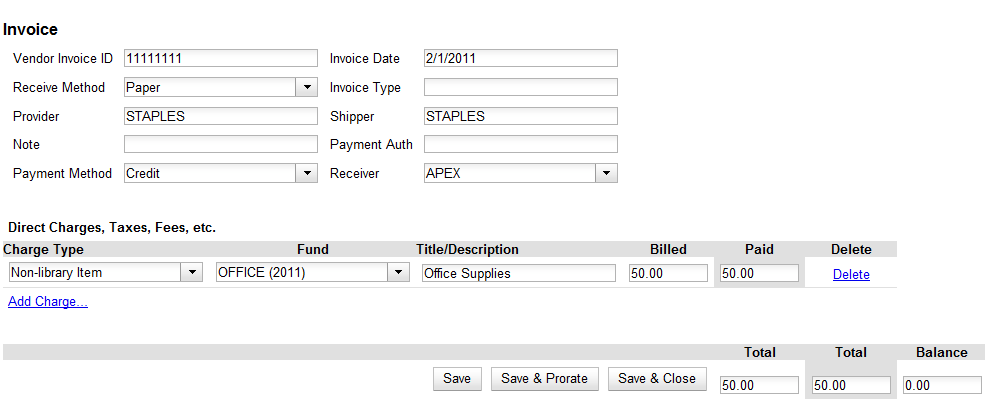
Adding line items from a Purchase Order or search results screen to an invoice
You can create an invoice or add line items to an invoice directly from a Purchase Order or an acquisitions search results screen.
-
Place a checkmark in the box for selected line items from the Purchase Order' or acquisitions search results page.
-
If you are creating a new invoice, click Actions → Create Invoice From Selected Line Items. Enter the invoice information in the top half of the screen.
-
If you are adding the line items to an existing invoice, click Actions → Link Selected Line Items to Invoice. Enter the Invoice # and Provider and then click the Link button.
-
Evergreen automatically enters the number of items that was ordered in the # Invoiced and # Paid fields. Adjust these quantities as needed.
-
Enter the amount that the organization was billed. This entry will automatically propagate to the Paid field.
-
You have the option to add charge types if applicable. Charge types are additional charges that can be selected from the drop-down menu. Common charge types include taxes and handling fees.
-
You have four options for saving an invoice.
-
Click Save to save the changes you have made while staying in the current invoice.
-
Click Save & Clear to save the changes you have made and to replace the current invoice with a new invoice so that you can continue invoicing items.
-
Click Prorate to save the invoice and prorate any additional charges, such as taxes, across funds, if multiple funds have been used to pay the invoice.
Prorating will only be applied to charge types that have the Prorate? flag set to true. This setting can be adjusted via Administration → Acquisitions Administration → Invoice Item Types. +
-
Click Close. Choose this option when you have completed the invoice. This option will also save any changes that have been made. Funds will be disencumbered when the invoice is closed.
-
-
You can re-open a closed invoice by clicking the link, Re-open invoice. This link appears at the bottom of a closed invoice.
Search for line items from an invoice
You can open an invoice, search for line items from the invoice, and add your search results to a new or existing invoice. This feature is especially useful when you want to populate an invoice with line items from multiple purchase orders.
In this example, we’ll add line items to a new invoice:
-
Click Acquisitions → Create Invoice.
-
An invoice summary appears at the top of the invoice and includes the number of line items on the invoice and the expected cost of the items. This number will change as we add line items to the invoice.
-
Enter the invoice details (optional). If you do not enter the invoice details, then Evergreen will populate the Provider and Receiver fields with information from the line items.
If you do not want to display the details, click Hide Details. 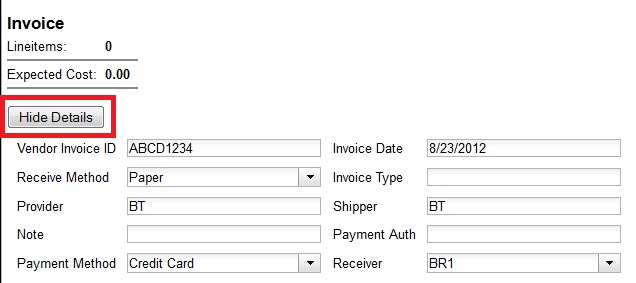
-
Click the Search tab to add line items to an invoice.
-
Select your search criteria from the drop-down menu.
-
On the right side of the screen, Limit to Invoiceable Items is checked by default. Invoiceable items are those that are on order, have not been cancelled, and have not yet been invoiced. Evergreen also filters out items that have already been added to an invoice. Finally, if this box is checked, and if your entered the invoice details at the top of the screen, then Evergreen will filter your search for items that have the same provider as the one that you entered. If you have not entered the invoice details, then Evergreen removes this limit.
-
Sort by title (optional). By default, results are listed by line item number. Check this box to sort by ascending title.
-
Building the results list progressively (optional). By default, new search results will replace previous results on the screen. Check this box for the search results list to build with each subsequent search. This option is useful for libraries that might search for line items by scanning an ISBN. Several ISBNs can be scanned and then the entire result set can be selected and moved to the invoice in a batch.
-
Click Search.
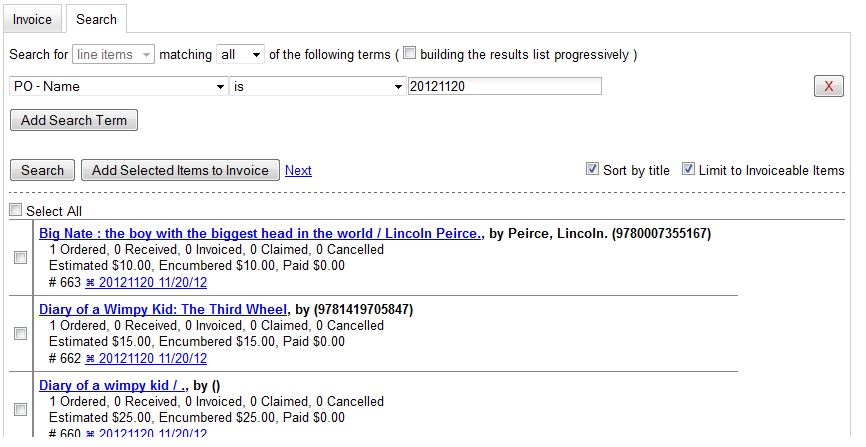
-
Use the Next button to page through results, or select a line item(s), and click Add Selected Items to Invoice. .The rows that you selected are highlighted, and the invoice summary at the top of the screen updates.
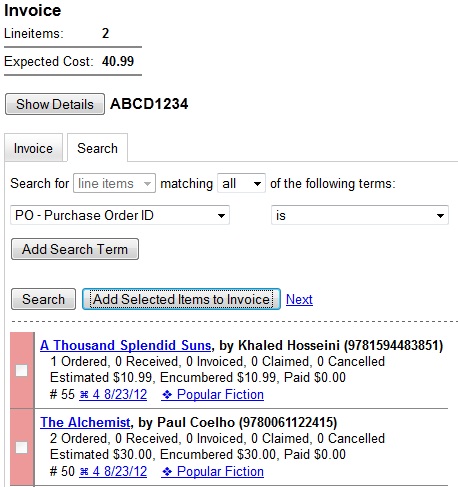
-
Click the Invoice tab to see the updated invoice.
-
Evergreen automatically enters the number of items that was ordered in the # Invoiced and # Paid fields. Adjust these quantities as needed.
-
Enter the amount that the organization was billed. This entry will automatically propagate to the Paid field. The Per Copy field calculates the cost of each copy by dividing the amount that was billed by the number of copies for which the library paid.
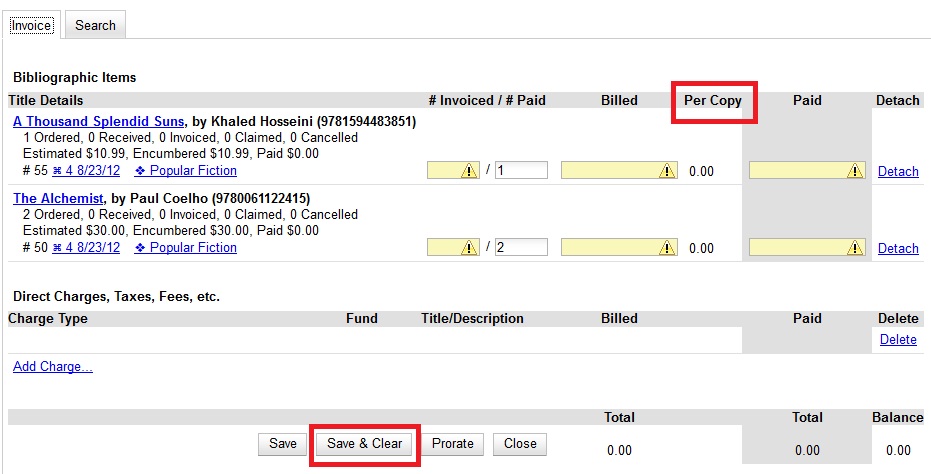
Create an invoice for a purchase order
You can create an invoice for all of the line items on a purchase order. With the exception of fields with drop-down menus, no limitations on the data that you enter exist.
-
Open a purchase order.
-
Click Create Invoice.
-
Enter a Vendor Invoice ID. This number may be listed on the paper invoice sent from your vendor.
-
Choose a Receive Method from the drop-down menu. The system will default to Paper.
-
The Provider is generated from the purchase order and is entered by default.
-
Enter a note (optional).
-
Select a payment method from the drop-down menu (optional).
-
The Invoice Date is entered by default as the date that you create the invoice. You can change the date by clicking in the field. A calendar drops down.
-
Enter an Invoice Type (optional).
-
The Shipper defaults to the provider that was entered in the purchase order.
-
Enter a Payment Authorization (optional).
-
The Receiver defaults to the branch at which your workstation is registered. You can change the receiver by selecting an org unit from the drop-down menu.
The bibliographic line items are listed in the next section of the invoice. Along with the title and author of the line items is a summary of copies ordered, received, invoiced, claimed, and cancelled. You can also view the amounts estimated, encumbered, and paid for each line item. Finally, each line item has a line item ID and links to the selection list (if used) and the purchase order. -
Evergreen automatically enters the number of items that was ordered in the # Invoiced and # Paid fields. Adjust these quantities as needed.
-
Enter the amount that the organization was billed. This entry will automatically propagate to the Paid field. The Per Copy field calculates the cost of each copy by dividing the amount that was billed by the number of copies for which the library paid.
-
You have the option to add charge types if applicable. Charge types are additional charges that can be selected from the drop-down menu. Common charge types include taxes and handling fees.
-
You have four options for saving an invoice.
-
Click Save to save the changes you have made while staying in the current invoice.
-
Click Save & Clear to save the changes you have made and to replace the current invoice with a new invoice so that you can continue invoicing items.
-
Click Prorate to save the invoice and prorate any additional charges, such as taxes, across funds, if multiple funds have been used to pay the invoice.
Prorating will only be applied to charge types that have the Prorate? flag set to true. This setting can be adjusted via Administration → Acquisitions Administration → Invoice Item Types. +
-
Click Close. Choose this option when you have completed the invoice. This option will also save any changes that have been made. Funds will be disencumbered when the invoice is closed.
-
-
You can re-open a closed invoice by clicking the link, Re-open invoice. This link appears at the bottom of a closed invoice.
Link an existing invoice to a purchase order
You can use the link invoice feature to link an existing invoice to a purchase order. For example, an invoice is received for a shipment with items on purchase order #1 and purchase order #2. When the invoice arrives, purchase order #1 is retrieved, and the invoice is created. To receive the items on purchase order #2, simply link the invoice to the purchase order. You do not need to recreate it.
-
Open a purchase order.
-
Click Link Invoice.
-
Enter the Invoice # and the Provider of the invoice to which you wish to link.
-
Click Link.

Electronic Invoicing
Evergreen can receive electronic invoices from providers. To access an electronic invoice, you must:
-
Configure EDI for your provider.
-
Evergreen will receive invoices electronically from the provider.
-
Click Acquisitions → Open Invoices to view a list of open invoices, or use the General Search to retrieve invoices. Click a hyperlinked invoice number to view the invoice.

View an invoice
You can view an invoice in one of four ways: view open invoices; view invoices on a purchase order; view invoices by searching specific invoice fields; view invoices attached to a line item.
-
To view open invoices, click Acquisitions → Open invoices. This opens the Acquisitions Search screen. The default fields search for open invoices. Click Search.

-
To view invoices on a purchase order, open a purchase order and click the View Invoices link. The number in parentheses indicates the number of invoices that are attached to the purchase order.

-
To view invoices by searching specific invoice fields, see the section on searching the acquisitions module.
-
To view invoices for a line item, see the section on line item invoices.
Receive Items From an Invoice
This feature enables users to receive items from an invoice. Staff can receive individual copies, or they can receive items in batch.
Receive Items in Batch (List Mode)
In this example, we have created a purchase order, added line items and copies, and activated the purchase order. We will create an invoice from the purchase order, receive items, and invoice them. We will receive the items in batch from the invoice.
1) Retrieve a purchase order.
2) Click Create Invoice.

3) The blank invoice appears. In the top half of the invoice, enter descriptive information about the invoice. In the bottom half of the invoice, enter the number of items for which you were invoiced, the amount that you were billed, and the amount that you paid.
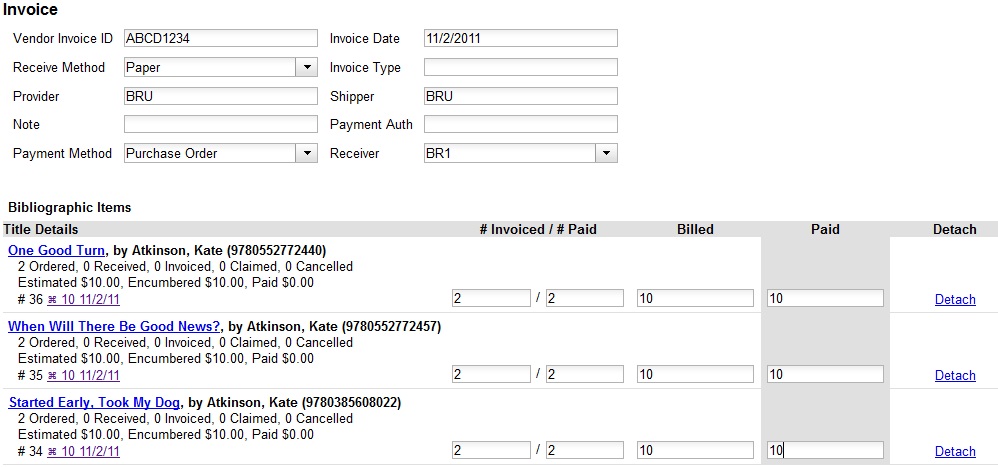
4) Click Save. You must choose a save option before you can receive items.
5) The screen refreshes. In the top right corner of the screen, click Receive Items.
6) The Acquisitions Invoice Receiving screen opens. By default, this screen enables users to receive items in batch, or Numeric Mode. You can select the number of copies that you want to receive; you are not receiving specific copies in this mode.
7) Select the number of copies that you want to receive. By default, the number that you invoiced will appear. In this example, we will receive one copy of each title.
| You cannot receive fewer items than 0 (zero) or more items than the number that you ordered. |
8) Click Receive Selected Copies.

9) When you are finished receiving items, close the screen. You can repeat this process as you receive more copies.
Receive Specific Copies (Numeric Mode)
In this example, we have created a purchase order, added line items and copies, and activated the purchase order. We will create an invoice from the purchase order, receive items, and invoice them. We will receive specific copies from the invoice. This function may be useful to libraries who purchase items that have been barcoded by their vendor.
1) Complete steps 1-5 in the previous section.
2) The Acquisitions Invoice Receiving screen by default enables user to receive items in batch, or Numeric Mode. Click Use List Mode to receive specific copies.
3) Select the check boxes adjacent to the copies that you want to receive. Leave unchecked the copies that you do not want to receive.
4) Click Receive Selected Copies.

The screen will refresh. Copies that have not yet been received remain on the screen so that you can receive them when they arrive.
5) When all copies on an invoice have been received, a message confirms that no copies remain to be received.
6) The purchase order records that all items have been received.
